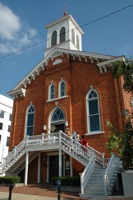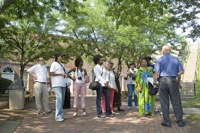 Courtesy Alabama Tourism Department
Courtesy Alabama Tourism Department
Last fall, the Alabama Tourism Department updated its two-year-old brochure on the Alabama Civil Rights Trail to include photos of President Barack Obama, Dr. Martin Luther King Jr. and Rosa Parks on the cover.
Edith Parten, public information manager for the department, said Obama’s election in 2008 sparked renewed interest in Alabama’s role in the Civil Rights movement.
However, Alabama has been courting African American visitors, both individuals and groups, for more than 20 years and was one of the first states to aggressively market to that travel segment.
Alabama’s Black Heritage, an extensive, 56-page guide to the state’s African American-related sites, went through several printings and was a forerunner to today’s promotional efforts.
“It [the Civil Rights Trail brochure] was birthed from the guide,” said Parten.
There was an explosion of interest in the African American market in the late 1990s and early 2000s, with numerous cities and states producing often elaborate guides to their African American heritage.
Although many of the guides are out of print, the marketing effort has not abated. Many convention and visitors bureaus and state travel offices are using current marketing techniques, especially on the Internet, and are attending the African American Travel Conference, where they have direct access to African American travel buyers.
Many Web sites have dedicated sections and specific itineraries for African American heritage, providing a wealth of information, advice and assistance to group leaders.
“The African American market is very strong for us,” said Ryan LaFata, media relations manager for the Hampton, Va., Convention and Visitors Bureau, which continues to distribute a glossy Family Tree guide to African American heritage sites in the coastal Virginia city.
“It’s huge,” said Parten. “Montgomery is ground zero for the Civil Rights movement, and Alabama as well. This is where history happened. It changed not only the state and nation, but the world.”
Alabama
One of Alabama state tourism director Lee Sentell’s projects has been the development of itinerary-style trails, including the Civil Rights Trail.
“The Black Heritage guide was to identify all those areas that had black history, to point out places of interest that had been attached to African Americans,” said Rosemary Judkins, Alabama’s group travel manager.
 |
| Courtesy Alabama Tourism Department |
Judkins said many of those places cannot be visited. “The Civil Rights Trail is a piece that helps you and guides you to all these different museums that tell the story,” she said.
“It makes it easier for people planning a visit,” said Parten. “They can look at the brochure, and it is laid out for them.”
People can download the 16-page Civil Rights Trail brochure from the state’s Web site, www.800alabama.com, or request a four-color printed version from the state.
The Web site also contains a special section on civil rights with overview copy that contains links to key sites. Another section of the Web site contains a variety of suggested itineraries, including a more detailed four-day itinerary for the Civil Rights Trail and a six-day itinerary that deals with the broader breadth of African American heritage.
Among the numerous sites on the Alabama Civil Rights Trail are the Selma to Montgomery National Historic Trail on U.S. Route 80 and its $10 million Lowndes County Interpretive Center; the Civil Rights Memorial Center, the Rosa Parks Museum, the Dexter Avenue King Memorial Baptist Church and the Dexter Parsonage Museum in Montgomery; the Edmund Pettus Bridge, the Brown Chapel A.M.E. Church and the National Voting Rights Museum in Selma; the Birmingham Civil Rights Institute and Birmingham’s Civil Rights District, which includes Kelly Ingram Park and the 16th Street Baptist Church; and the Tuskegee Human and Civil Rights Multicultural Center.
The Road to Freedom itinerary begins in Mobile with a driving tour of Africatown, still home to descendants of slaves who were aboard Clotlde, the last slave ship to arrive in America.
According to the Web itinerary: “Following emancipation, the former slaves returned from various plantations, bought land and formed Africatown, ruling it according to customary African laws and speaking their own regional language.”
www.800alabama.com
(800) 252-2262
Hampton, Va.
Bruce Newton, group sales manager for the Hampton CVB, said 30 to 40 motorcoaches a year come to the annual Hampton Jazz Festival in June, one of the most popular events for African Americans.
“We make sure they see our heritage sites during the day and the African American festival that goes on downtown at the same time,” said Newton.
 |
| Courtesy Hampton CVB |
“They want to do the same things as all groups: experience the waterfront, enjoy great food and downtown shopping and street festivals. But their emphasis is different as far as historical.
“We don’t design a tour specifically for African American groups, but if we know they have a heritage interest, we will feature more of the heritage sites. And we still have the Family Tree publication we mail out to groups that have specific interest in heritage sites.”
The publication is named in honor of the Emancipation Oak, a National Historic Landmark at the entrance to Hampton University. Abraham Lincoln’s Emancipation Proclamation was read to Hampton’s black community from beneath the sprawling tree.
“Hampton University is one of the oldest African American universities, and the oldest African American museum is on that campus,” said LaFata.
The Hampton University Museum, founded in 1868, has more than 9,000 objects and works of art from a number of cultures around the world.
“Aberdeen Gardens, which has its own museum, was built for and by African Americans in the 1930s as part of Franklin D. Roosevelt’s New Deal Settlement,” said LaFata. “It is very tight-knit. You will still see families that have been there for generations, with a grandmother living next door to a grandchild.”
www.hamptoncvb.com
(800) 487-8778
Baltimore
The Baltimore Area Convention and Visitors Bureau’s African American Heritage and Attractions Guide, first printed more than six years ago, can be downloaded from its Web site.
The 26-page guide features sections on historic landmarks, religious venues, colleges and universities, visual and performing arts, cultural heritage attractions, heritage museums, and cultural shops and boutiques.
The guide also includes a brief history of Baltimore, annual cultural events and festivals, a list of heritage tours and tour operators, a family reunions section and a list of other African American attractions in Maryland.
The guide also features short sections about famous African Americans associated with Baltimore, such as Harriet Tubman and the Underground Railroad; musicians Cab Calloway, Eubie Blake and Billie Holiday; and Negro Leagues baseball star Leon Day, and a feature on the city’s historic African American neighborhood along Pennsylvania Avenue.
The introduction notes: “Most people think of the Inner Harbor when they think of Baltimore … But not too far from the Inner Harbor lie treasures in history, art and culture. That’s what the African American Heritage and Attractions Guide is all about. We’ll introduce you to places that you may not have heard of and others that you’ve wanted to see.
“Visit the National Great Blacks in Wax Museum, the nation’s first wax museum of African American history. Explore the worlds of jazz legends like Eubie Blake and contemporary performers like Donte Winslow. Plus there’s dining, shopping and culture to experience in Baltimore’s rich and diverse neighborhoods.”
Other Baltimore African American sites include the Reginald F. Lewis Museum of Maryland African American History and Culture, the East Coast’s largest African American museum, and the Frederick Douglass-Isaac Myers Maritime Park, which honors Douglass, the prominent 19th-century African American leader, and Myers, the first black owner of a marine railway shipyard in the United States.
www.baltimore.org
(877) 225-8466
Buffalo/Niagara
The Buffalo Niagara Convention and Visitors Bureau, which plays host to the African American Travel Conference in April, also makes its four-color African American Heritage Guide available online.
The 32-page publication, which can also be obtained in print form, has sections on black Buffalo history, festivals, cultural institutions, historic sites, food, shopping, churches and nightspots.
It also has itineraries, a reunion and group event planner, and short biographies of famous Buffalo African Americans, such as 19th-century educator and reformer Mary Burnett Talbert.
It also has a feature on the Niagara Movement, led by W.E.B. DuBois, which became the basis for the founding of the NAACP.
Because of its proximity to Canada, Buffalo was an important stop on the Underground Railroad and has several sites associated with the system of aiding escaping slaves, among them the Michigan Street Baptist Church, built in 1845 by its African American congregation.
Any black musician who visited Buffalo in the 1930s, 1940s and 1950s had to check in at the Colored Musicians Club, formed in 1917 as Local No. 533. Dizzy Gillespie, Art Blakey, Duke Ellington, Count Basie, Billie Holiday and Ella Fitzgerald all jammed there.
Today, the club promotes the preservation of jazz and holds a jam session on Sunday evenings. Groups can also attend the rehearsals Monday through Thursday evenings.
www.buffalocvb.org
(888) 228-3369, ext. 237
Indianapolis
The Indianapolis Convention and Visitors Association has discontinued publication of its multicultural guide, which included a large section on African Americans, for a more general approach to marketing.
“Through our rebranding and as we continue to grow, our marketing efforts toward the African American market have evolved into a more mainstream approach,” said Chris Gahl, media relations manager for the CVA. “But we have tours that point out the historic sites.”
An itinerary on the CVA’s Web site has details about African American sites, along with the cost, the estimated time to visit and the contact information.
“The Madame Walker Theater is certainly an attraction on a variety of tours,” said Gahl.
The ornately restored theater, with African art-deco motifs and mirrored ballroom, was built in honor of Madam C.J. Walker, the nation’s first self-made female millionaire. The theater has a room with memorabilia of Walker.
Martin Luther King Park has a memorial to King and Robert Kennedy, who were assassinated within months of each other in 1968. Kennedy was campaigning in Indiana for the Democratic presidential nomination on the April day King was shot and killed in Memphis, Tenn., and was slated to give a speech at a rally in the park.
“He gave a pretty stirring off-the-cuff speech on peace and race relations to droves of African Americans and other folks who had come to hear him,” said Gahl. “Indianapolis was one of only a handful of cities that didn’t have rioting [in the wake of the King assassination]. There is a memorial that honors both slain leaders that is very powerful.”
Gahl said two annual events that draw many African American visitors are the Summer Celebration in July and the Circle City Classic in October.
“Summer Celebration is the longest running and largest African American cultural event in the United States,” he said. “It draws in quite a lot of visitors, more than 100,000. There is a pretty wide offering of activities.”
The 11-day celebration includes health screenings, a free concert with big-name entertainment, gospel music and a large gathering of vendors selling African American-related art, music and clothing.
The weekend Circle City Classic features a celebrity gala on Friday night, a parade through downtown Indianapolis and a football game between two historically black colleges on Saturday at Lucas Oil Stadium, the home of the Indianapolis Colts.
“A lot of group tours peg their trips around this weekend,” said Gahl.
www.indy.org
(317) 684-2496
(800) 322- 4639










